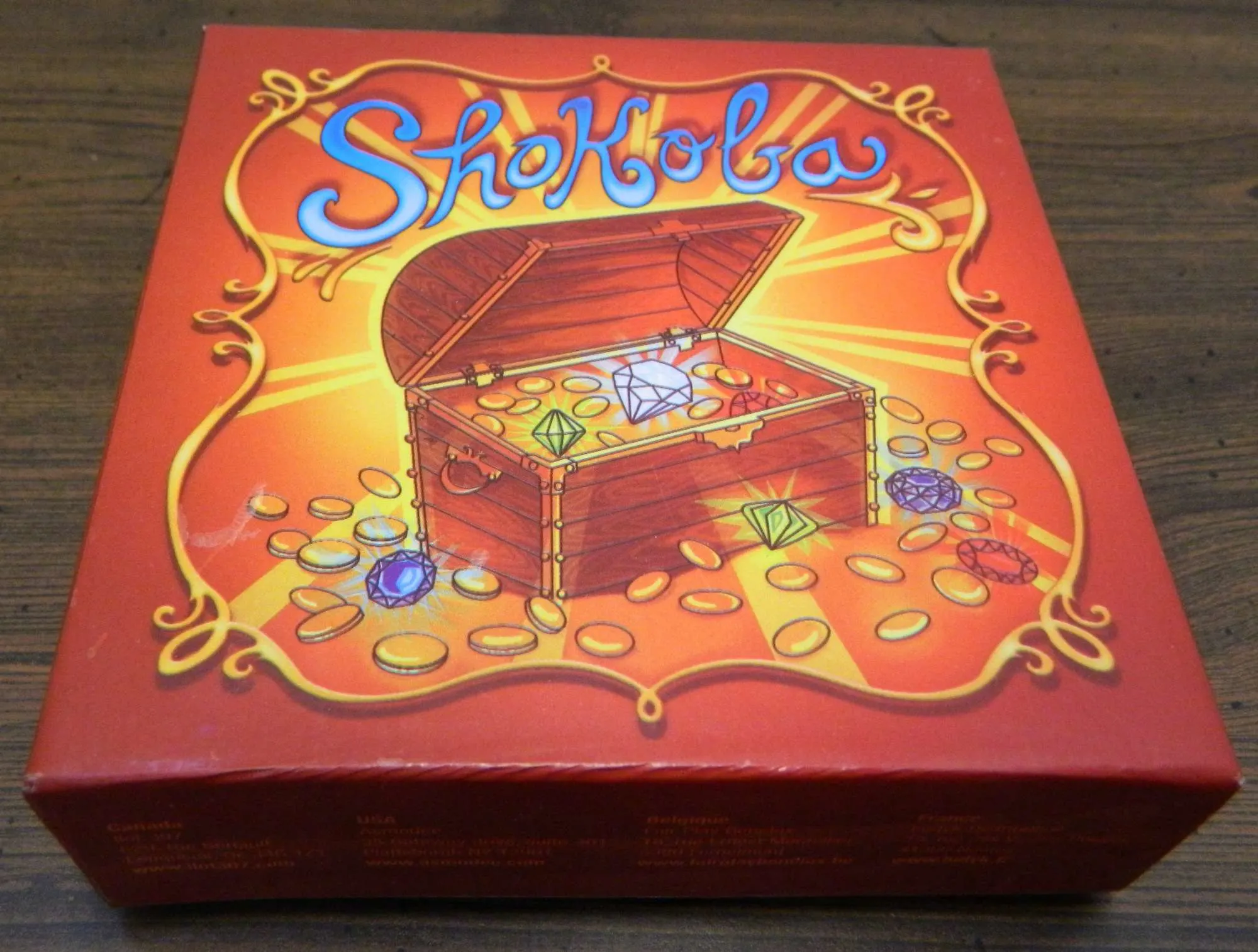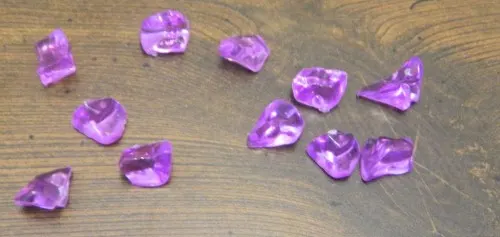How to Play
Objective
To be the first player/team to reach 11 points.
Setup
Shokoba can be played individually or in teams of two. If playing in teams the players sit opposite one another. Each player has their own cards but cards are combined during the scoring phases.
Shokoba is played in rounds. Each round begins with the dealer dealing three cards to each player and then flipping four cards face up on the table. When all of the cards have been played a new round begins with the next player being the dealer.
The youngest player is the first dealer.
Playing A Round
On a player’s turn they play one of their cards to the table. Players want to play a card whose number matches one or more of the cards on the table. If a player plays a six card they could possibly take several different cards from the table. The player could take a six card. The player could also take a one, two, and three card since they add up to six. The player could take any set of cards that exactly equal six. The colors of the gems do not matter at this stage since they are just used for scoring. If the player is able to match a card/cards, they take the card they played as well as the card/cards they matched and put the cards in their scoring pile. These cards stay in the scoring pile until the scoring phase.
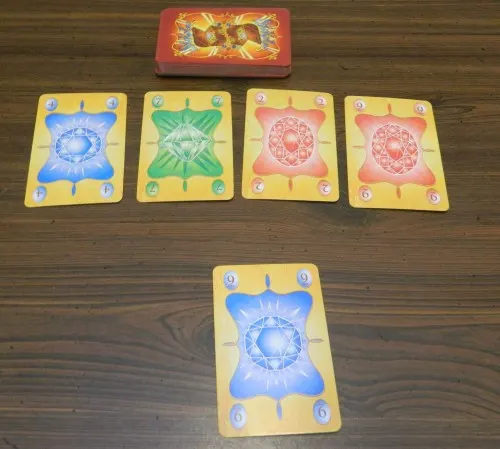
The current player played a nine card. They can either take the red nine card or both the green seven and red two card.
If a player plays a card that clears all of the cards from the table they say “Shokoba”, they take all of the cards on the table, and they take a plastic gemstone.
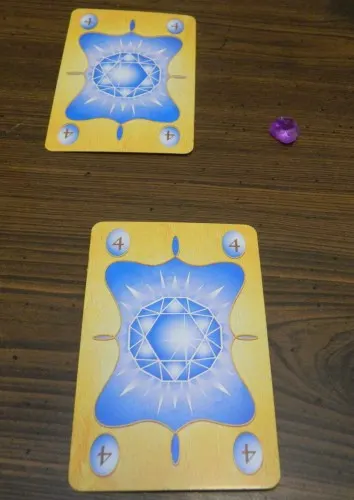
The current player played a card that clears the last face up card from the table. They take the cards from the table and take a gemstone for clearing the table.
If a player doesn’t have any cards that match any of the cards on the table, they must play one of their cards to the table. That card stays on the table so players may collect it in future turns.
Once each player has played all three of their cards, each player is dealt three more cards and the round continues. The player that started the round as the dealer, stays the dealer for the whole round. When the deck runs out of cards and everyone has played their last card, the round ends. The player who played the last card that took cards from the table gets to take the rest of the face up cards from the table. They don’t get to take a plastic gem for clearing the board unless they were able to clear the board with the card that they played.
Scoring
When the round ends, scoring begins. Players flip over the cards in their score pile and sort the cards based on the colors of the gems. Up to five plastic gemstones will be handed out based on the cards collected by each player. The plastic gemstones are given out as follows:
- One gemstone goes to the player who got the diamond card since there is only one diamond card in the deck.
- One gemstone goes to the player with the most emeralds (green).
- One gemstone goes to the player with the most rubies (red).
- One gemstone goes to the player with the most sapphires (blue).
- One gemstone goes to the player with the most total cards.
If two or more players have the same number of cards for one of the categories, no one receives the gemstone for that category. If after scoring no one has enough gemstones to win the game, a new round begins with the next player becoming the dealer.
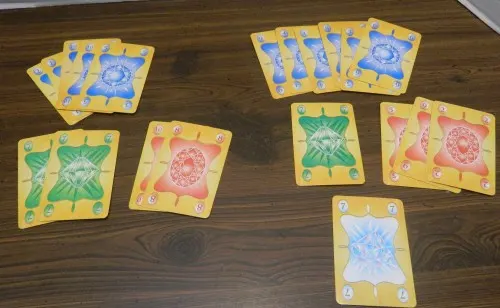
Here are the hands of two players. The left player would get one gemstone since they have the most green cards. The right player would get four gemstones since they have the most blue gemstones, red gemstones, diamonds, and the most total cards.
Winning the Game
The first player to reach 11 gemstones (or another agreed upon total) wins the game. If two people surpass 11 gemstones after the same round, the player who has more total gemstones wins the game. If the tie is still not broken another round of the game is played to determine who wins the game.
Review
If I had to describe Shokoba I would say that it is a mix of a matching, card and memory game. Basically you play cards that match cards on the table. You can either match numbers directly or can match a group of cards on the table that add up to the card that you played. The memory aspect comes into play as you try to remember which cards you have collected since you need to acquire the most cards in a color in order to receive the points for that color of cards. While not perfect, I had fun with Shokoba.
Shokoba’s greatest strength is its’ simplicity and its’ length. You could teach the game to a new player within minutes and they should fully understand the game within a couple rounds. This should make Shokoba appealing to people who have a lot of non-gamers that they would like to play games with. The simplicity should also make the game accessible for children. The recommended age is 8+ but I think younger players could play the game if they have good addition skills.
Shokoba works really well as a filler game since it is quick to play. The game will usually take around 15-30 minutes to complete. Once you get used to playing the game, players only need seconds to make their decisions which makes the rounds go by really quickly. The scoring is quite simple so you don’t have to waste a lot of time tallying scores. If you are looking for a game that is quick but still satisfying, Shokoba may be it.
Other than the simplicity and quickness, the thing I liked most was the scoring system. I like games where you can score in multiple different ways. Shokoba would have been a boring game if you just scored points for gathering the most cards. Instead you need to decide which colors you are going to go for which adds a memory aspect into the game as you need to try and remember which cards you and the other players collected during the round. This forces players to decide how they are going to approach a given round.
While Shokoba doesn’t have a lot of strategy, there are two areas where strategy comes into play.
If you have no options to take cards from the table, you are going to have to play one of your cards to the table. This decision has two strategies with neither appearing to have a significant advantage. You can play down a low card since they are not very valuable in collecting other cards. They give other players more options in which to take multiple cards though. On the other hand the high value cards are more useful for taking cards from the table but also prevent players from taking multiple cards on their turn when played to the table.
The other time that strategy comes into play is when the player has a couple different options of which cards they can take from the table. This decision comes down to two things: quantity and color. If you can collect the diamond card you should always choose that option since it gets you a gemstone automatically. Next it is best to get green or red gems. If you aren’t going for a specific color though you are probably going to want to take as many cards as possible to help with the total cards and possibly give you enough cards of one color to claim that gemstone as well.
This is where the memory element comes into play. While it is not crucial, remembering which cards you have already collected in a round can help you in situations where you have multiple options of which cards you can take. If you are far behind in one of the colors it doesn’t really pay to pursue cards of that color outside of collecting more cards to help get the most total cards. Knowing how many of each color card you have will also help tell you when you can stop collecting a certain color. For example if you already have two green cards there isn’t much reason to collect more since you will already win that color.
Not surprisingly the biggest problem with Shokoba is the fact that the game relies a lot on luck. The luckiest player is probably going to win the game. Whichever player gets the best cards in their hand and has the right cards come up on the table will have a huge advantage since they will be able to take more cards from the table. The reason luck is so important in the game is that most of the time your best option is usually obvious. Players that usually have cards in their hand that match the cards on the table are likely to win since they will be able to take more cards than the other players.
Theoretically the luck should balance itself out since each player takes turns being the dealer and players should generally have similar luck with card draw and the cards that are put out on the table. The game for some reason though seems to favor some of the players. In the game I played, all of the luck seemed to go to one of the players. They regularly got good cards and every time a card got put on the table it seemed to be the exact card that the player needed. That player ended up scoring almost as many points as all of the other players combined. This was probably just a coincidence but if you hate luck in your games you may not like Shokoba.
The component quality for the MJ Games version of the game are kind of hit and miss. The artwork on the cards isn’t that bad but it is kind of bland. The card quality seems a little cheap compared to other card games. The plastic gemstones are nicer than cardboard tokens though. The components don’t ruin the game but they definitely are not a reason to specifically buy the game.
Final Verdict
Generally I wouldn’t like a game like Shokoba. The game relies a lot on luck and the decisions to be made in the game are usually pretty obvious. Despite these issues, I still had fun with Shokoba. The game is so quick to play and is fun. It is far from a strategic game but it works well as a simple filler that you can introduce to non-gamers.
If you hate games that rely on a lot of luck, you won’t like Shokoba. If you are looking for an easy and quick filler game though I think you could do a lot worse than Shokoba.
If you would like to purchase Shokoba, you can purchase it on Amazon. Shokoba

